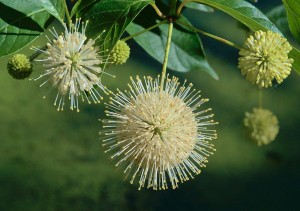 When you see or hear something—plants, animals, situations—several times in a short span of hours or days, the universe is probably trying to send you a message. This past week, the message I received was about buttonbush, known to botanists as Cephalanthus occidentalis. On three separate days, I saw buttonbushes in three separate parks in my home county. All were in full bloom, so it was hard not to take notice.
When you see or hear something—plants, animals, situations—several times in a short span of hours or days, the universe is probably trying to send you a message. This past week, the message I received was about buttonbush, known to botanists as Cephalanthus occidentalis. On three separate days, I saw buttonbushes in three separate parks in my home county. All were in full bloom, so it was hard not to take notice.
As with many plants, the Latin name says a lot. It comes from two Greek words—“kephale”, which means “head”, and “anthos”, meaning “flower”. You find “anthos”, either hiding or in plain sight, in many flower names, including: chrysanthemum; helianthus, otherwise known as sunflower; and leucanthemum, the best known of which is the much-loved Shasta daisy.
Buttonbush, which may also be known as, button willow, honey bells, or honey balls, got its common name from its head-shaped flowers, which are about one inch in diameter, perfectly round and fragrant. If you can imagine little, round white or pinkish porcupines, you will have a good idea of the appearance of buttonbush blooms. The protruding “spines”—which are not sharp—are in fact, pistils, the female reproductive parts of the flower.
Those “honey balls” are borne in clusters on multi-branched shrubs that grow between five to 12 feet tall and four to eight feet wide. The bright green leaves are shaped like elongated ovals and appear in pairs or whorls. Woody plant guru, Dr. Michael Dirr, comments, “Leaves emerge late in spring and the plant looks dead until mid-May.” I think this sounds harsh, as many plants look similarly dead before springing to vibrant life. In early spring I am generally fixated on the daffodils anyway.
In addition to its beauty, buttonbush is a pollinator magnet. The Xerxes Society, an invertebrate conservation group, says that buttonbush “is frequented by skippers, monarchs, and virtually any butterflies that happen to be passing by.” It is also a host plant for large moths like the beautiful titan sphinx and hydrangea sphinx. The alluring fragrance of the blooms and the nectar inside them draws bees as well as hummingbirds.
The white “buttons” are succeeded by red ones, which are actually the fruits of the plants. As if to compensate for the spring deadness, those fruiting bodies persist into winter.
Gardeners tend to be optimists, but there are always those who will ask, “So…what is the downside of this plant?”
If you have a small garden, size may be an issue. Fortunately, breeders have come up with ‘Sugar Shack’, a variety that grows only three to four feet tall, and reputedly offers good fall leaf color in addition to its other virtues.
Even if you have plenty of room, you may not cotton to the somewhat gangly habit of the buttonbush. The plants can be shaped into a tidier, rounded configuration by regular pruning. They can also be grown in standard or tree form by removing all but the sturdiest lower branch or branches and removing new growth as it appears below the crown. I have done that successfully with the equally gangly and obstreperous rose-of-Sharon shrub, providing myself with a more disciplined plant and room to grow annuals and perennials underneath.
Buttonbush is a North American native, making it a perfect candidate for native plant landscapes and habitat restoration. It absolutely adores having wet feet and is often found in the wild in swampy places or beside ponds or streams. In rainy seasons when the water is high, buttonbushes will even flower when standing in water.
If you invest in a buttonbush, either put it in a damp spot, along with your astilbes, chelone and other moisture lovers, or provide regular supplemental water when the weather is even slightly dry. If you happen to have a rain garden or swale, a buttonbush will fit right in.
Swale or no swale, you may be able to find a buttonbush at well-stocked local nurseries, especially those that carry shrubs under the “Proven Winners” label. You can also order one for fall planting from Prairie Nursery, W5875 Dyke Ave, Westfield, WI; 800-476-9453; www.prairienursery.com.
